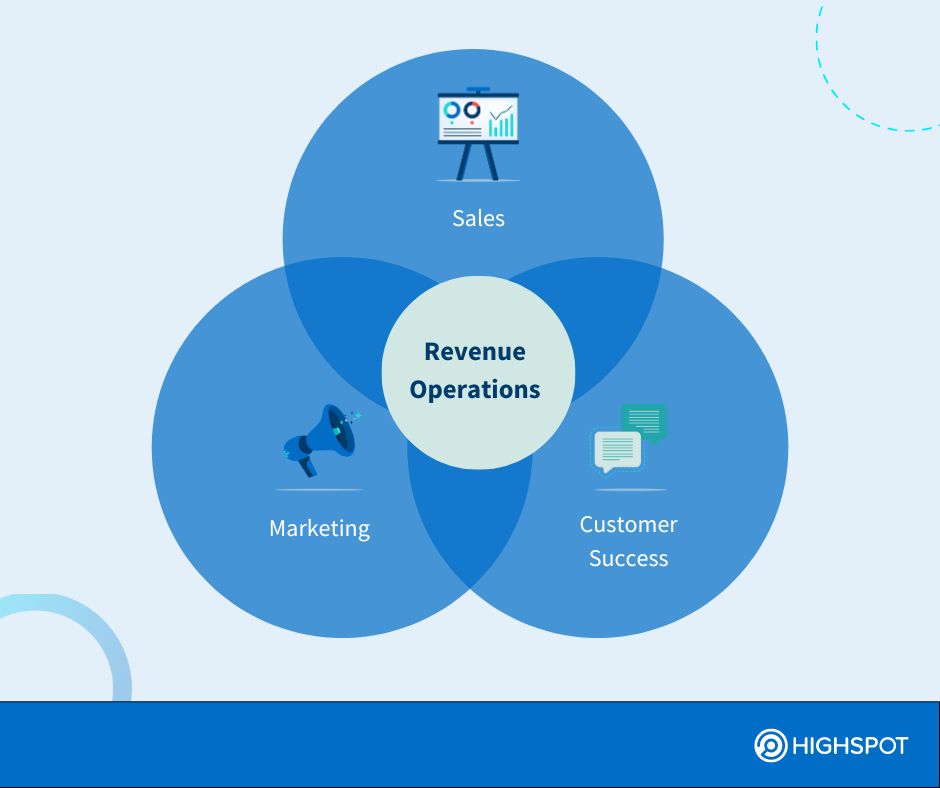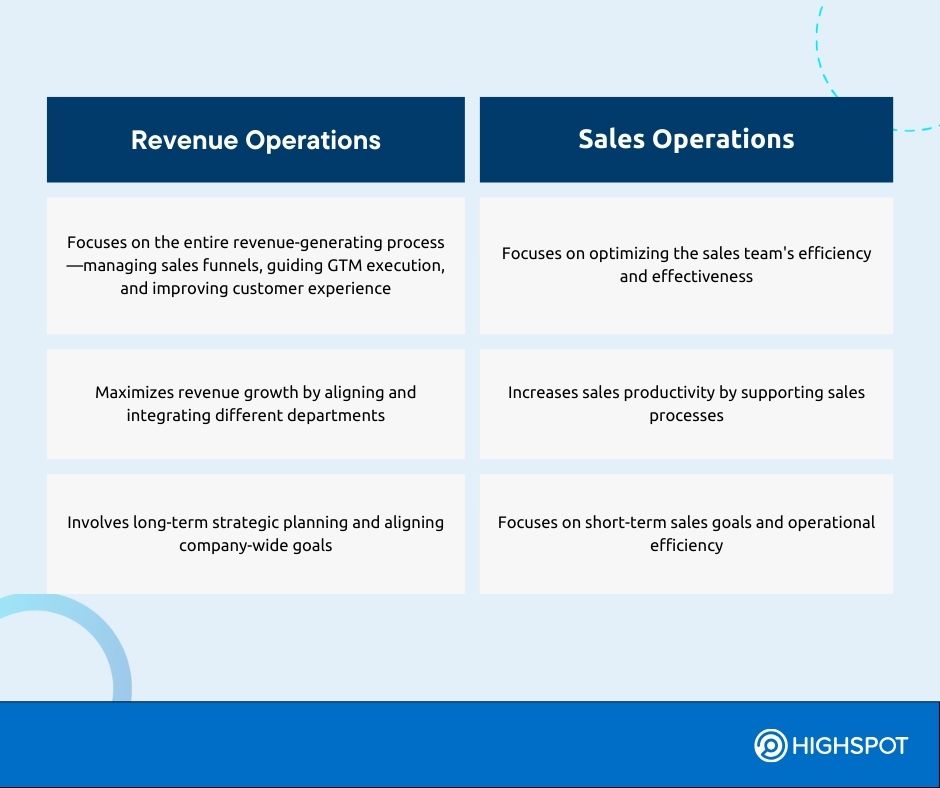Key Takeaways
- Revenue operations bridges gaps between teams to drive sustainable revenue growth and achieve better business outcomes.
- It reduces friction on the customer journey to maximise lifetime value and retention.
- It drives consistent performance through standardised processes and clear metrics and KPIs.
Imagine trying to grow your business while everyone on your team pulls in different directions. Marketing generates leads that don’t quite match what sales needs, sales chases targets without a clear view of what’s coming down the pipeline, and customer success struggles to keep clients happy. This disconnection can lead to missed opportunities and lost revenue.
Revenue operations, or RevOps, is here to change that. It provides a unified, data-driven approach to streamline processes and scale revenue. According to Gartner, 75% of the highest-growth companies will deploy a RevOps model by 2025. It’s no wonder that the role of Chief Revenue Officer (CRO) or Head of Revenue Operations is now one of the fastest-growing positions.
If you want to boost your bottom line, revenue operations might just be your next big move. This article will explore revenue operations’ true purpose, highlight common pitfalls, and guide you on implementing it effectively, ensuring your business reaps the full benefits.
What is Revenue Operations?
Revenue operations is a business function that aligns cross-functional teams—primarily sales, marketing, and customer success—toward a common goal of driving and accelerating revenue growth. Besides optimising processes, it helps predict revenue more accurately and gives a clear view of how all revenue teams perform.
By breaking down silos, RevOps improves communication and provides teams with the tools, data, and insights they need to collaborate effectively and focus on shared goals. This, in turn, creates a seamless customer journey, from lead generation to closing deals.

How Does Revenue Operations Work?
Revenue operations starts with aligning sales, marketing, and customer success around common goals, encouraging collaboration. It then integrates data from various sources to provide visibility throughout the customer lifecycle, which helps teams make strategic decisions and forecast more accurately.
Revenue operations also connects existing systems and tools in the tech stack—such as CRM, marketing platforms, and analytics—to automate data exchange and coordinated actions across departments. As a result, sales reps gain access to a unified customer profile, ensuring that every interaction is informed and relevant. Marketing team delivers targeted content that aligns with the customer’s journey, avoiding irrelevant new sale offers, for instance, when an upsell is more appropriate. When the deal is closed, the customer success team is fully aware of what’s been promised so they can deliver exactly what the customer expects.
This alignment transforms fragmented efforts into a powerful, cohesive strategy, making it a game-changer for businesses looking to scale. It reduces customer frustration and enhances the overall experience, leading to higher satisfaction, loyalty, less customer churn, and, ultimately, more successful sales outcomes.
How Does Revenue Operations Differ from Sales Operations?
Although the terms are sometimes used synonymously, revenue operations and sales operations differ in their scope.
Sales ops concentrates on improving the sales team’s effectiveness. It focuses on key areas like deal management, territory planning, sales forecasting, CRM management, and training and development.
Meanwhile, RevOps takes a broader view, overseeing the entire customer journey, managing sales funnels, guiding go-to-market (GTM) execution, and enhancing the overall customer experience. This holistic approach ensures that all departments work together seamlessly toward shared revenue goals.

Benefits of Revenue Operations
RevOps can transform a disconnected organisation into a cohesive, well-oiled machine. Here’s how RevOps enhances everything from revenue generation to adaptability.
1. Boost Revenue
It can determine new revenue streams by optimising the customer journey from start to finish and beyond. This can help you acquire and retain more customers, ultimately increasing their lifetime value.
2. Improve Efficiency
RevOps breaks down silos and streamlines workflows across departments by implementing standardised processes. This can eliminate redundant data entry, reduce manual errors, and save countless hours each week. Furthermore, efficiency improves when you automate routine tasks, helping teams focus on what truly drives customer acquisition.
3. Increase Productivity
It isn’t just about efficiency—it’s about doing more with the same resources. B2B tech companies that implemented RevOps saw a 10% to 20% increase in sales productivity, showing how operational alignment can lead to significant gains in performance.
4. Adapt to Market Changes
What happens when there is a supply chain disruption or other market shift? RevOps equips companies with the agility to respond quickly. By realigning go-to-market strategies and keeping everyone informed, businesses can maintain customer trust and avoid significant revenue loss during critical periods.
5. Deliver a Seamless Customer Experience
It’s a common frustration: a prospect participates in a marketing campaign and shows interest in a product, only to speak with sales and find they have no idea who you are. This disconnect happens when systems aren’t integrated.
The RevOps team creates a consistent and connected customer journey, with everyone aligned and informed. When the right hand knows what the left is doing, customers experience a seamless interaction with higher satisfaction and retention rates. McKinsey emphasises that companies with strong customer experience (CX) strategies, often supported by RevOps, achieve double the revenue growth of those lagging in CX.
6. Better Data Insights
RevOps unifies business data management so that all teams have more insight into customer behaviour. This allows for targeted marketing campaigns and more impactful sales tactics. As a result, customers receive better service, no matter how or when they interact with your company and salesforce.
How to Implement Revenue Operations
Kicking off a RevOps implementation is no small undertaking. It is a significant project that requires time, investment, and careful planning. You will work with business leaders to manage expectations and nurture cross-functional collaboration at every stage.
Here’s a step-by-step guide to help you successfully implement RevOps in your organisation:
1. Identify Your Goals and Objectives
The first step in implementing RevOps is clearly defining your goals and objectives. What do you want to achieve? Whether it’s increasing revenue, improving customer retention, or enhancing operational efficiency, having clear, measurable SMART goals will guide your RevOps strategy. For example, a company might work to improve cross-departmental collaboration in an effort to boost customer lifetime value by 20% over the next year.
2. Define Team Structure With Clear Roles and Responsibilities
Use your go-to-market process to identify any gaps in roles. You may need to redefine some existing roles or recruit new ones for your revenue operations team.
Team members often include:
- Chief Revenue Officer
- Revenue Operations Manager
- Sales Operations Manager
- Marketing Operations Manager
- Customer Success Manager
- Systems Operations Manager
- Product Manager
To make RevOps work, you’ll need a combination of skills. Strong analytical and problem-solving are essential for data-driven decision-making and resolving workflow issues. Meanwhile, communication and collaboration are key for aligning teams across sales, marketing, and customer success.
Besides that, you need technical proficiency with CRM systems and marketing automation tools, plus solid project management and organisational skills to handle multiple initiatives. Understanding sales processes and having strategic thinking skills are vital for long-term planning. Finally, a commitment to continuous learning helps you stay ahead.
3. Determine the Right Tech Stack
Based on your earlier assessments, decide on the technology stack that will serve as your single source of truth. Choose tools that integrate well and avoid fragmenting with tools that overlap functions and don’t communicate with each other. Integration and automation will provide all teams access to the same reliable data and workflows will be streamlined.
4. Invest in Support, Training, and Coaching
New strategies, technology, and processes need continuous nurturing and refinement. Provide ongoing support, answer questions, and ensure that everyone stays informed. For instance, a company could offer hands-on workshops, online tutorials, incentives, and regular Q&A sessions when implementing a new tool.
A revenue enablement platform can be invaluable for streamlining this process. It centralises resources, tracks progress, and provides personalised training to ensure that each team member is up to speed.
Designating “RevOps champions” within each department to address questions and provide guidance can further ease the transition. A feedback loop as part of overall revenue enablement also helps refine processes as issues arise, ensuring everyone is comfortable.
Common Challenges in Implementing Revenue Operations
RevOps sounds like a great investment, but it is not without its hurdles. However, you can overcome them with the right people, processes, technology, and data.
Some common challenges you might face include:
Lack of Executive Buy-in
Getting the necessary resources and alignment can be tricky without strong support from the top. Executives need to see the value of RevOps to back it up.
To overcome this, give them a clear roadmap, which should include:
- Expected benefits and ROI
- Step-by-step action plan with estimated completion dates
- Possible challenges and how you’ll address them
- Breakdown of your budget
Insufficient Resources
Sometimes, not having enough resources, such as budget, staff, or technology, can slow down your RevOps journey. Be sure your communication is solid and business leader buy-in is secure upfront. If you’re at a startup, take things slow. Demonstrate the value of RevOps through gradual changes, and then, as you build your case, request additional resources.
Siloed Data
One of the biggest obstacles to a successful RevOps implementation is data locked away in different departments. It’s hard to get the full picture and make informed decisions when data isn’t accessible to everyone. In that case, be sure to choose a CRM that can integrate seamlessly with the rest of your tech stack and all revenue-generating teams can access.
Resistance to Change
Change can be scary, and getting everyone on board with a new way of working isn’t always easy. Teams may be used to long-standing workflows and may feel that new processes will disrupt their efficiency. Changes in roles, responsibilities, and tools can also overwhelm employees, leading to frustration and resistance.
To address resistance to change, clearly explain RevOps’ goals and benefits, ensuring all team members understand how it aligns with your organisation’s strategy. You should also lead by example, provide ongoing revenue enablement, support, and training on new processes and technologies, and adapt your system based on feedback and evolving circumstances.
When Does Revenue Operations Make Sense for My Business?
Implementing RevOps can be a game-changer, but it’s especially beneficial in certain scenarios. Here are some business models where RevOps makes the most sense:
- SaaS or subscription-based business: If your business relies on recurring revenue, like in SaaS or subscription models, RevOps helps ensure that every department is aligned to maximise customer lifetime value and renewals. The nature of these businesses requires continuous coordination to keep customers engaged and reduce customer churn.
- High-growth startup: Startups in a rapid growth phase often struggle with scaling their sales processes efficiently. RevOps brings structure and alignment to fast-growing companies, ensuring that your operations can keep up as your sales and customer base expand without becoming chaotic.
- Sizable or growing sales team: It’s easy for silos to form and for processes to become inconsistent when your sales team is growing. RevOps helps create standardised workflows, integrates customer data across teams, and ensures everyone is working toward the same revenue goals.
- Overwhelming tech stack: If you’re juggling multiple tools and technologies that don’t integrate well, leading to siloed data and communication problems, RevOps works to integrate your tools into a cohesive system. You’ll have a single source of truth, simplified workflows, and technology that supports your revenue goals rather than hindering them.
- Complex customer journeys: If your business deals with long, complex revenue cycles that involve multiple touchpoints, RevOps can help keep client engagement consistent and relevant. This reduces friction in the buyer’s journey and improves the overall experience, leading to higher conversion rates and customer satisfaction.
Unlock Sustainable Growth with Revenue Operations
Aligning your revenue process throughout the sales funnel, marketing efforts, and relationships is a strategic advantage and essential for sustainable growth in today’s competitive market. Companies that successfully implement the RevOps function are seeing real-time revenue growth, faster sales cycle, improved customer satisfaction, and more streamlined operations. In fact, organisations that align their revenue efforts before and after the sale see 71% higher stock performance and 3x faster revenue growth than those that aren’t aligned. But remember, the goal is to reduce friction, not add to it.
If you’re looking to enhance your RevOps enablement and fully align your revenue teams, Highspot can help. Book a demo today!




